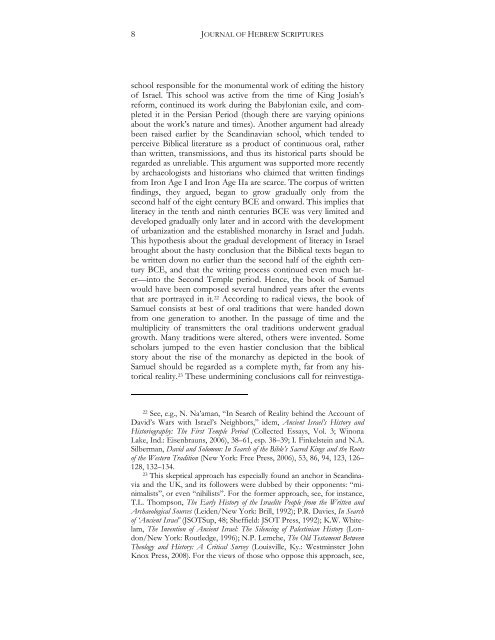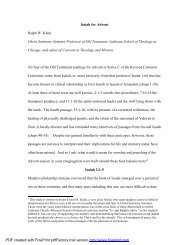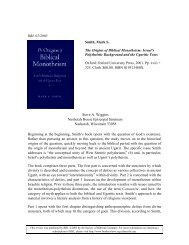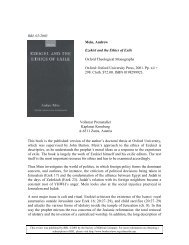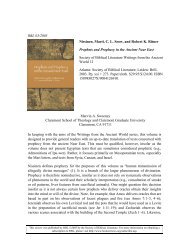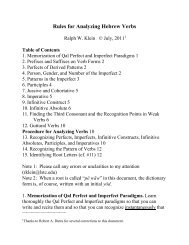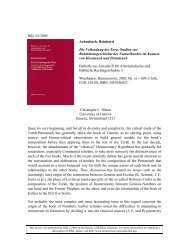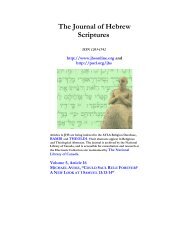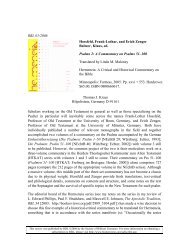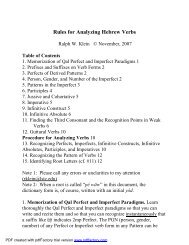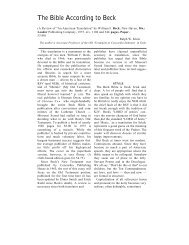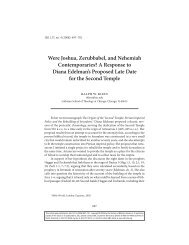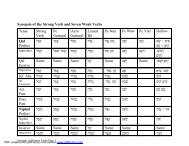The Book of Samuel: Its Composition, Structure and Significance as ...
The Book of Samuel: Its Composition, Structure and Significance as ...
The Book of Samuel: Its Composition, Structure and Significance as ...
Create successful ePaper yourself
Turn your PDF publications into a flip-book with our unique Google optimized e-Paper software.
8 JOURNAL OF HEBREW SCRIPTURES<br />
school responsible for the monumental work <strong>of</strong> editing the history<br />
<strong>of</strong> Israel. This school w<strong>as</strong> active from the time <strong>of</strong> King Josiah’s<br />
reform, continued its work during the Babylonian exile, <strong>and</strong> completed<br />
it in the Persian Period (though there are varying opinions<br />
about the work’s nature <strong>and</strong> times). Another argument had already<br />
been raised earlier by the Sc<strong>and</strong>inavian school, which tended to<br />
perceive Biblical literature <strong>as</strong> a product <strong>of</strong> continuous oral, rather<br />
than written, transmissions, <strong>and</strong> thus its historical parts should be<br />
regarded <strong>as</strong> unreliable. This argument w<strong>as</strong> supported more recently<br />
by archaeologists <strong>and</strong> historians who claimed that written findings<br />
from Iron Age I <strong>and</strong> Iron Age IIa are scarce. <strong>The</strong> corpus <strong>of</strong> written<br />
findings, they argued, began to grow gradually only from the<br />
second half <strong>of</strong> the eight century BCE <strong>and</strong> onward. This implies that<br />
literacy in the tenth <strong>and</strong> ninth centuries BCE w<strong>as</strong> very limited <strong>and</strong><br />
developed gradually only later <strong>and</strong> in accord with the development<br />
<strong>of</strong> urbanization <strong>and</strong> the established monarchy in Israel <strong>and</strong> Judah.<br />
This hypothesis about the gradual development <strong>of</strong> literacy in Israel<br />
brought about the h<strong>as</strong>ty conclusion that the Biblical texts began to<br />
be written down no earlier than the second half <strong>of</strong> the eighth century<br />
BCE, <strong>and</strong> that the writing process continued even much later—into<br />
the Second Temple period. Hence, the book <strong>of</strong> <strong>Samuel</strong><br />
would have been composed several hundred years after the events<br />
that are portrayed in it. 22 According to radical views, the book <strong>of</strong><br />
<strong>Samuel</strong> consists at best <strong>of</strong> oral traditions that were h<strong>and</strong>ed down<br />
from one generation to another. In the p<strong>as</strong>sage <strong>of</strong> time <strong>and</strong> the<br />
multiplicity <strong>of</strong> transmitters the oral traditions underwent gradual<br />
growth. Many traditions were altered, others were invented. Some<br />
scholars jumped to the even h<strong>as</strong>tier conclusion that the biblical<br />
story about the rise <strong>of</strong> the monarchy <strong>as</strong> depicted in the book <strong>of</strong><br />
<strong>Samuel</strong> should be regarded <strong>as</strong> a complete myth, far from any historical<br />
reality. 23 <strong>The</strong>se undermining conclusions call for reinvestiga-<br />
22 See, e.g., N. Na’aman, “In Search <strong>of</strong> Reality behind the Account <strong>of</strong><br />
David’s Wars with Israel’s Neighbors,” idem, Ancient Israel’s History <strong>and</strong><br />
Historiography: <strong>The</strong> First Temple Period (Collected Essays, Vol. 3; Winona<br />
Lake, Ind.: Eisenbrauns, 2006), 38–61, esp. 38–39; I. Finkelstein <strong>and</strong> N.A.<br />
Silberman, David <strong>and</strong> Solomon: In Search <strong>of</strong> the Bible’s Sacred Kings <strong>and</strong> the Roots<br />
<strong>of</strong> the Western Tradition (New York: Free Press, 2006), 53, 86, 94, 123, 126–<br />
128, 132–134.<br />
23 This skeptical approach h<strong>as</strong> especially found an anchor in Sc<strong>and</strong>inavia<br />
<strong>and</strong> the UK, <strong>and</strong> its followers were dubbed by their opponents: “minimalists”,<br />
or even “nihilists”. For the former approach, see, for instance,<br />
T.L. Thompson, <strong>The</strong> Early History <strong>of</strong> the Israelite People from the Written <strong>and</strong><br />
Archaeological Sources (Leiden/New York: Brill, 1992); P.R. Davies, In Search<br />
<strong>of</strong> ‘Ancient Israel’ (JSOTSup, 48; Sheffield: JSOT Press, 1992); K.W. Whitelam,<br />
<strong>The</strong> Invention <strong>of</strong> Ancient Israel: <strong>The</strong> Silencing <strong>of</strong> Palestinian History (London/New<br />
York: Routledge, 1996); N.P. Lemche, <strong>The</strong> Old Testament Between<br />
<strong>The</strong>ology <strong>and</strong> History: A Critical Survey (Louisville, Ky.: Westminster John<br />
Knox Press, 2008). For the views <strong>of</strong> those who oppose this approach, see,


